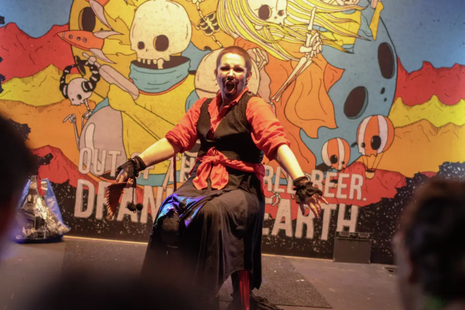The drag kings staging gender in Cambridge
Varsity speaks to drag kings at the ADC and beyond

In a performance at the ADC theatre, Jesus Christ is the main character in a destabilised crucifixion scene. Overhead thunders the voice of Sam Allberry, an evangelical pastor. He states that “the ultimate dysphoria” was Christ bearing our sins: “the ultimate feeling of being in the wrong flesh.” When first hearing this, August, who plays as drag king Justa Knight, thought “surely what he’s saying is that Jesus is trans.” Indeed, in their staged interpretation, ‘Beelzechub’, played by drag king Clit Eastwood, emerges from the wings, pierces the trans Jesus with the Lance of Longinus, and so performs the first top surgery in history.
This performance is one of many plays on masculine archetypes produced by a dynamic group of drag kings and things in Cambridge. This group cannot be reduced to female-bodied people putting on male stereotypes. Instead, these kings are making ambitious and subversive rediscoveries of gender.
“Drag allowed me to push my gender in my day-to-day life”
August describes drag as the heightening of gender, taking in the gendered elements of everyday life and extending them to their logical conclusions. But these ‘caricatures’ of masculinity have a critical bite. Lily’s drag king, Bert I’m A Cheerleader, is an “oily rat man” who is “a bit slimy but not on the side of creepy or nefarious but more comical or inept.” This act “takes some of the power out of this idea of masculinity.” Lily admits that it emerged when a friend said: “this act can either go sexy or creepy, and I think you’d be better at creepy.” In any case, drag kings take the opportunity to amplify male characters. August becomes Jesus, but also a fantastical knight-errant in “alternative non-binary monster-fucker drag.”
These performances free gender expression. “Drag allowed me to push my gender in my day-to-day life. None of it looks that extreme next to what I’ve done in drag,” says Lily. In fact, while the influence is not always direct, many drag performers are transgender and their characters sometimes run parallel with changes to their gender identity. Drag proves that what people think is innate is not so. When putting on drag for the first time, August wore a binder, which contributed to their realisation that “I was non-binary, that non-binary existed, and that I needed to do something about that.” Their top surgery and the start of their drag involvement were four months apart. On the other hand, Lily finds that drag performance and gender expression are very separate.
Drag likewise changes experiences of the body. Frida uses their king Dyke Van Dick to perform sexiness without being objectified. “Performing as a drag king with a beard on is a lot more freeing, but they can still appreciate my tits”, he says. Even so, August emphasises that drag can be “funny or sexy or both.” The performances and characters vary, but the recurrent theme is freedom.
However, drag is not a diversion from real experiences of gendered people. These performers are female-bodied and have experienced what some men can be like. “I think quite carefully about how I can be masculine without harming anyone”, says Lily, whose project is “softening masculinity with just a little guy or just some lad.” Lily will only be macho in a silly way because gender is a serious issue at the core of our social lives. They say that: “Bert is a fun character to put on [...] but I do not want to be Bert.”
Even so, drag is good fun. Kings perform with Dragtime at the ADC but also at May Balls and June Events. Frida notes that different considerations are required when transitioning between these audiences, but drag shows that “gender fuckery is being accepted into mainstream society.” Most heartening is the acceptance of uncertain gender categories. August finds a “gender of the day”, like “goblin-gender,” “frog” or a “little monster.” Frida says that drag defies the kind of culture that says you must find a label: “It is about experimentation and fucking about with gender and seeing where you end up.”
It is true that drag is a confrontational art. The language might be offensive, the costumes lurid and the stereotypes grotesque. However, for these kings and monstrous things, the safest environment is the most liberated. Constraint is not a drag word. Nor does it confine the lines of flight performers make as they soar over the brackets of gender that we take for granted. Instead, they take gender for a ride, driving it into that big middle space where there is no binary. But they do not pretend for one moment to have disentangled themselves from the problems of gendered life. On the contrary, drag kings look at their gender like a distorting funhouse mirror and laugh.
 News / Eight Cambridge researchers awarded €17m in ERC research grants27 December 2025
News / Eight Cambridge researchers awarded €17m in ERC research grants27 December 2025 News / Clare Hall spent over £500k opposing busway 24 December 2025
News / Clare Hall spent over £500k opposing busway 24 December 2025 Comment / League tables do more harm than good26 December 2025
Comment / League tables do more harm than good26 December 2025 Comment / The ‘class’ of Cambridge24 December 2025
Comment / The ‘class’ of Cambridge24 December 2025 News / Caius mourns its tree-mendous loss23 December 2025
News / Caius mourns its tree-mendous loss23 December 2025










